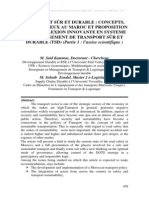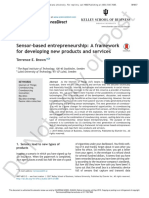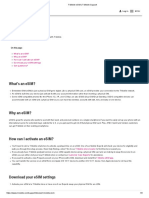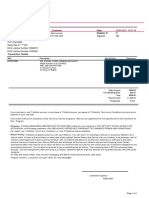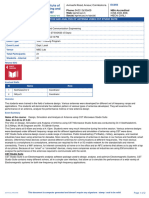Nokia and the insistent ringing of
competition
By John Gapper
In 1983, Nike enjoyed dominance of its industry, with a market share of more than 35
percent, having crushed Adidas, its original rival. But a tiny competitor was about to
knock it sideways: Reebok.
A similar situation exists today with Nokia and Samsung. Although the Finnish company's
share of the global market for mobile handsets is similar to Nike's in athletic shoes 21
years ago, its South Korean competitor has momentum. Samsung's camera phones, with
twisting flip-up screens that allow users to take, send and display photos quickly and
easily, are hot; Nokia's are not.
Samsung's market capitalization exceeded that of Nokia last week as this fact became
evident in the companies' first-quarter results. Even more annoying for Nokia is the
transfer of something intangible, yet highly valuable: market leadership. The high end of
the market - phones that retail for $300 or more in the US – is no longer Nokia's.
Samsung makes the expensive camera phone that a young consumer wants to have.
Nokia seems to realise how potentially serious its situation is, but two obstacles stand in
the way of Nokia regaining authority. One (product design) should be solvable, given the
company's heritage. The other (that Samsung is South Korean) will be harder to tackle, as
other western companies are likely to find as well.
Design should be Nokia's strength, since it originally overtook Motorola by turning
handsets into handsome and desirable consumer goods, rather than bland technological
objects. Yet in its recent models, Nokia appears to have forgotten the first rule of
modernist design - that form follows function. Instead, it has placed most emphasis on
making its handsets colourful and zappy, with snap-on covers.
Samsung's approach to digital communication has more substance. Its twisting flip-up
screen is a neat way of making the most or camera technology. The screen can even be
folded outwards, so friends' photos appear when they call.
There is no obvious reason why Nokia should not regain its lead in design. But Samsung
has another advantage, which is more difficult for any European rival to counter: the
willingness of young South Koreans to pay high prices for new electronic devices. In
terms of access to broad band and telecommunications infrastructure, Samsung
happens to be sitting in one of the world's most wired - and wireless – markets.
�Nokia had a similar advantage in Finland in the 1990s and exploited it to 100 establish a
strong presence round the world, including in Asia. But Europe has trailed Asia in high-
speed mobile services. South Korea has more than 5m subscribers to third-generation
services. That has helped Samsung to develop better designs for camera handsets at
home before applying the lessons in Europe and the US.
One thing Samsung learnt - and Nokia did not - was to make its camera handsets small.
Masamichi Udagawa, co-founder of Antenna Design in New York, says he was 'shocked'
when he saw one of Nokia's first camera phones in Tokyo; companies such as Panasonic
and Sharp were already making much smaller models for Japan. 'It was a nice design,
with a sliding lid, but its sheer size made it unacceptable,' he says.
For consumer companies in Europe and US, Nokia's experience points to a broader
challenge. Nike has remained innovative by developing a range of premium-priced shoes
in the US and then selling them around the world.
Samsung has shown that companies in Asian economies can use their own domestic
markets to develop global products. Of course, Japanese companies, including Sony and
Toyota, have done that for several decades, blending design and technology in ways
unmatched by western companies. But countries such as South Korea have a
demographic advantage over Japan and Europe - a plentiful supply of young people. As
Southeast Asian economies develop, those consumers will become increasingly valuable.




















